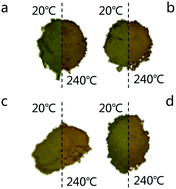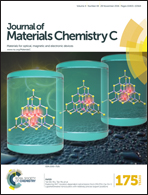Structure, optical spectroscopy properties and thermochromism of Sm3Fe5O12 garnets
Abstract
Reversible thermochromic inorganic materials change colour with temperature, which are used in temperature indicator devices, such as temperature sensors, laser marking and warning signals. In this paper, we report a series of thermochromic materials of rare-earth iron garnets Sm3−xCaxFe5O12 (x = 0, 0.1, 0.3, 0.5). All samples were prepared by a high temperature solid state reaction by repeated grinding and calcination of high purity Sm2O3, Fe2O3 and CaO. The sample structure and optical behaviour were characterized by powder X-ray diffraction (XRD), the Mössbauer spectrum, infrared (IR), Raman and UV-vis-NIR spectroscopy. All results showed the pure phase of Sm3−xCaxFe5O12 (x = 0, 0.1, 0.3, 0.5) with Ca2+ partially substituted Sm3+ at C sites. The Mössbauer spectrum indicates that Fe3+ shows mixed valence states in Ca2+ doped samples. Thermochromism of all Sm3−xCaxFe5O12 (x = 0, 0.1, 0.3, 0.5) samples showed the change in colour from green to brown and the introduction of Ca2+ ions shows gradual tunability of colour. Temperature-dependent XRD and UV-vis spectra indicated that a continuous structural evolution accompanied by Fe3+–O bond length stretching is the main reason for the thermochromic properties. Thus, this paper provides a family of new thermochromic materials for potential thermometric applications.


 Please wait while we load your content...
Please wait while we load your content...